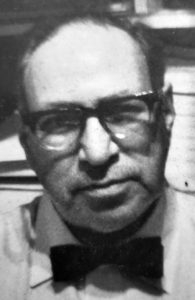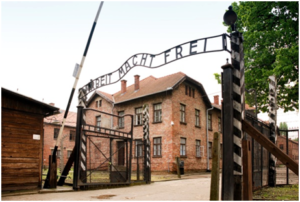By Karen Yaffe Lottes

WASHINGTON GROVE, Maryland — Last week, the Russians bombed Babi Yar in Ukraine, a monument to the victims of the Holocaust. This seems the right moment to share portions of a letter my grandfather, Richard Yaffe, wrote in 1949 after visiting Auschwitz. My grandfather was a journalist and in 1949, between jobs, he convinced CBS to hire him as a correspondent while he and my grandmother, Sara Yaffe, traveled through Europe. They spent a great deal of time in Poland and my grandfather, who was both a Jew and a man who was deeply concerned about the inequities afforded people of different races and nationalities, found the experience profound. In June 1949, he wrote this letter to his friends about his experience.
*
(By Richard Yaffe)
 KRAKOW, Poland — I wonder if you have ever heard of Herbert Meyer of Lodz? I can’t blame you if you haven’t, because I never ran into his name before today. Now, I’ll never forget it. Herbert Meyer of Lodz never did anything spectacular that I have heard of, and the Jews of Lodz who remain can’t remember much about him either. He was just a Jew, an ordinary Jew who went to synagogue on the Sabbath and on Holy Days. I know that much about Herbert Meyer because I have seen and felt his Talith, of pure wool and well worn. He had a wife and at least one child, a little girl of about two. I know that, too, because I saw and felt the nursery bottle from which she fed and whose red rubber nipple is cracking now, as rubber cracks from age and disuse.
KRAKOW, Poland — I wonder if you have ever heard of Herbert Meyer of Lodz? I can’t blame you if you haven’t, because I never ran into his name before today. Now, I’ll never forget it. Herbert Meyer of Lodz never did anything spectacular that I have heard of, and the Jews of Lodz who remain can’t remember much about him either. He was just a Jew, an ordinary Jew who went to synagogue on the Sabbath and on Holy Days. I know that much about Herbert Meyer because I have seen and felt his Talith, of pure wool and well worn. He had a wife and at least one child, a little girl of about two. I know that, too, because I saw and felt the nursery bottle from which she fed and whose red rubber nipple is cracking now, as rubber cracks from age and disuse.
I know nothing positive about Herbert Meyer of Lodz, but I can guess at some things: he was no labor leader in Old Poland, because Jews held no such positions. Neither was he a worker in heavy industry, nor a politician, nor a government official, nor a tramway conductor, not a railway worker, nor a thousand other things. Jews could be none of these in Old Poland. His little bag that I saw today could give me no clues to Herbert Meyer, except perhaps this small one: there was a thimble open at both ends such as the thimble I used to see in a little tailor shop of a friend of my father’s, a man also called Meyer Who and also and who also called Poland his home. So, I think Herbert Meyer was a tailor, a poor tailor made his few zloty a month, and took care of his duties as a father and a Jew as best he could and whose prayers on Passover and Yom Kippur, “Next year, Jerusalem,” were a little more heartfelt than those I have heard as a boy and a man in America.
Why, then, did I see the few things that remain of Herbert Meyer where I saw them? What did they want of this poor tailor, and his 6 million brother tailors and cobblers and doctors and lawyers and dentists and shopkeepers and rabbis and journalists and mothers and fathers and babies. What crimes had they committed other than that of being a Jew? That, evidently, was enough.
I wish I could have spoken one word with Herbert Meyer at the place where I saw his last earthly possessions. I spoke with others there, others who had gone through almost as much as Herbert Meyer, but not quite. These others had been saved at the last minute by people on our side, although we are a little reluctant to remember that they were on our side. The Russians of course. These others had been in the same place as Herbert Meyer, but it was not the same. These others are alive, and even though they remain, and even though they lived through almost everything that Herbert Meyer lived through, they tell you that it is getting to be like a bad dream, that even though they see it every day they are beginning to ask themselves if it really was true, that if it really wasn’t just a long nightmare. And they wipe their eyes as they tell you this, and they ask you, “Have you seen the ghetto in Warsaw? You see, time has a way of trying to hide the scars. You noticed, perhaps, that grass is already trying to cover the ruins of the ghetto in Warsaw?”
*

The main gate as you enter Oswiecin, which the Germans called Auschwitz, has over the legend, “Arbeit Macht Frei.” My guide, whose Oswiecin number was engraved both on his arm and heart, said as I looked at this legend, “There were three ways to go free from here: work to death, don’t work and be slain, and just be slain.”
He showed us first Rudolph Hoesse’ mansion from which the gory lord of Osweicin ruled and slaughtered. Then he showed me the spot at which Hoess was hanged. “Six million times?” I asked. “Only once,” he replied.
From that spot to where I saw the last possessions of Herbert Meyer was just a short walk — for us. for those that entered through the “Arbeit Macht Frei” gate, the walk was to eternity
The house was marked “Kanada,” the name given by the prisoners to the methodical things the Germans did — to the hair they cut from human heads and sent back home for industrial purposes, to the soap they made from the Jewish bodies in which they proudly labeled “pure”, to the shoes they sorted, to the teeth they pulled for the gold that was in them, for the dozens of other uses they made of those they sacrificed on the altar of their insane Fuhrer and insane lust.
I saw Herbert Meyer’s belongings on a in a room on the second floor of the house marked “Kanada.” His belongings were a little cloth bag from which peak the talith of good wool and the baby’s bottle with the cracked red nipple. His little torbe was only one of hundreds, and these were only a few of the millions that those who preserved Osweicin as a museum have been able to gather and preserve.
From there we went to a room whose opening was covered with a rug. My guide asked if I wanted to see what was behind the rug, and I said that I did. He pulled it aside and there was a glass Box with hair from 40,000 Jews – red hair and blonde hair and black hair, curly and straight, long braids and short, and even a few little gay ribbons that some mother had put so proudly into her little daughter’s hair.
Then the room full of talithim.
Then room full of artificial limbs and crutches — only the useless ones; the better ones had been picked through by the Superman to send back to Berlin.
And then the shoes. Three-hundred-thousand pairs of shoes. Shoes piled and stacked along three of the four walls of a room the size of a ballroom. Dirty, torn shoes, and dainty clean shoes, some marked Amsterdam, some marked Brussels, some marked Athens, some Paris, and even one gay little pair of beach shoes marked Biarritz. These, too, were the discarded shoes; the better ones were also sent back home and came to my mind that every time I would see a German. I would have to look at his shoes and wonder.
And then the little room. The little room with little shoes, gone at the toes, some of them, reminding me of the little shoes that were gone at the toes when my son was three or four, the age these children were.
On a shelf over these shoes sat a doll.
Then the clothes room, stacks have neatly sorted underthings and over-clothes, sorted into dark and light colors, and by articles of apparel.
Oh, but these Germans were methodical…
Cages of eyeglasses, cages and umbrellas, of toothbrushes, of combs, of knives and forks, of cosmetics – of everything that man needs or thinks he needs, when he starts on a long journey.
Oh, but these Germans were methodical…”
*
As Ukrainian President Volodymyr Zelensky said (and I paraphrase), it’s as if the victims of the Holocaust were killed twice with the bombing of Babi Yar.
*
Karen Yaffe Lottes is the program coordinator at the Gaithersburg Community Museum in Maryland. Her grandfather, the late Richard Yaffe, served as the foreign editor of PM, an advertising-free New York City newspaper, and later was the United Nations correspondent for the Jewish Chronicle of London and associate editor of The Jewish Week. He was the founding editor of Israel Horizons magazine.